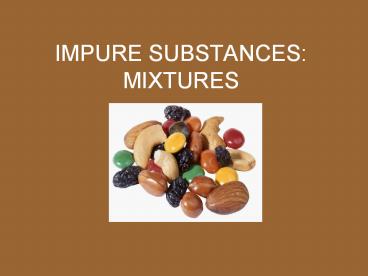IMPURE SUBSTANCES: MIXTURES - PowerPoint PPT Presentation
1 / 27
Title:
IMPURE SUBSTANCES: MIXTURES
Description:
IMPURE SUBSTANCES: MIXTURES PROPERTIES OF MIXTURES A mixture is a combination of two or more substances that are not chemically combined PROPERTIES OF MIXTURES No ... – PowerPoint PPT presentation
Number of Views:346
Avg rating:3.0/5.0
Title: IMPURE SUBSTANCES: MIXTURES
1
IMPURE SUBSTANCES MIXTURES
2
PROPERTIES OF MIXTURES
- A mixture is a combination of two or more
substances that are not chemically combined
3
PROPERTIES OF MIXTURES
- No Chemical Changes in a Mixture No chemical
changes happen when a mixture is made. So, each
substance has the same chemical makeup it had
before the mixture was formed. - Making a mixture is a
- physical change.
4
PROPERTIES OF MIXTURES
- Separating Mixtures Through Physical Methods
Mixtures can be separated by using physical
changes. Physical changes do not change the
identities of the substances. - Some methods could be distillation, evaporation,
filtration, dissolve, use of magnets,
centrifugation,and chromatography.
5
(No Transcript)
6
PROPERTIES OF MIXTURES
- The Ratio of Components in a Mixture The
components of a mixture do not need to be mixed
in a definite ratio. - For example, granite is a mixture of different
minerals. Different ratios of the minerals give
granite different colors, but the mixture is
always called granite.
7
MIXTURES AND COMPOUNDS
Mixtures Compounds
Made of elements, compounds or both Made of elements
No change in original properties of the components Change the original properties of the components
Heat or electricity not required for separating the components Heat or electricity required for separating the components
Made using any ratio of the components Made using a fixed ratio of components
8
TYPES OF MIXTURES
- There are three types of mixtures
- Homogeneous mixtures Colloids
- Heterogeneous mixtures
9
HETEROGENEOUS MIXTURES
- The different components can be seen as
individual substances. We can almost separate the
components with our eyes. - The particles are visible (bigger particles)
10
HOMOGENEOUS MIXTURES
- Have the same composition throughout.
- Any one region of the mixture has the same ratio
of substance as any other region - The components cant be seen as individual
indentifiable entities - Mixed as much finer level, not readily
distinguished
11
COLLOIDS
- Is a mixture in which the particles are spread
throughout but are not large enough to settle out - The particles are not as small as those of a
solution, however are smaller than those of a
suspension
12
COLLOIDS
- Particles in a colloid are large enough to
scatter light. A colloid cannot be separated by
passing it through a filter.
13
COLLOIDS
- Consists of two separated phases Disperse phase
(or internal phase) and a continuos phase (or
dispersion medium). - May be solid, liquid or gas
- Some are translucent because of the Tyndall
Effect (which is the scattering of light)
14
Types of colloids
Continuos phase
Disperse phase
Gas Liquid Solid
Gas None Liquid aerosol Ex fog, mist, hair spray Solid aerosol Ex cloud, smoke, air
Solid Solid foam Exaerogel, styrofoam Gel Ex jelly, silicagel Solid sol Ex cranberry glass
Liquid Foam Ex whipped cream, shaving cream Emulsion Ex milk, mayonnaise, hand cream Sol Ex blood
15
TYPES OF HOMOGENEOUS MIXTURES
- SOLUTIONS (single phase)
- A solution is a mixture that appears to be a
single substance. The process in which particles
of substances separate and spread evenly
throughout a mixture is known as dissolving. - In a solution, the solute is the substance that
is dissolved. The solvent is the substance in
which the solute is dissolved.
16
TYPES OF HOMOGENEOUS MIXTURES
- Examples of Solutions Liquid solutions include
soft drinks, gasoline, and tap water. Solutions
may also be gases, such as air. - Solutions may also be solids, such as steel.
Alloys are solid solutions of metals or nonmetals
dissolved in metals.
17
SOLUTIONS
- Particles in Solutions The particles in
solutions are so small that they never settle
out. They also cannot be removed by filtering. - The particles in solutions are so small that
they dont even scatter light.
18
SOLUTIONS
- Concentrated or Dilute? Solutions can be
described as being concentrated or dilute. But
these two terms do not tell you the amount of
solute that is dissolved. - Concentration amount of solute
- amount of solution
19
(No Transcript)
20
- Solubility is the ability of a solute to dissolve
in a solvent at a certain temperature. Depends on
the attractions of solute particles for one
another and attractions of solvent particles for
one another.
21
- Dissolving Gases in Liquids Gases become less
soluble in liquids as the temperature is raised. - Dissolving Solids Faster in Liquids Three ways
to make a solute dissolve faster are mixing the
solution, heating the solution, and crushing the
solute into smaller particles.
22
(No Transcript)
23
SOLUTIONS
- Unsaturated solution
- A solution that has not reached the limit of
solute that will dissolve - Saturated solution
- A solution in which no more solute can be
dissolved
24
TYPES OF HETEROGENEOUS MIXTURES
- SUSPENSIONS
- A suspension is a mixture in which particles of a
material are dispersed throughout a liquid or a
gas but are large enough that they settle out. - The particles in a suspension are large enough
to scatter or block light. A suspension can be
separated by passing it through a filter.
25
SUSPENSIONS
- Different components are in different phase, such
as solids in liquids or liquids in gases - It is necessary to shake the substance before
using it
26
HETEROGENEOUS MIXTURES
- You can distinguish the two or more phases.
27
SOLUTIONS, SUSPENSIONS AND COLLOIDS
Solutions Suspensions Colloids
Uniformly dispersed More or less dispersed Intermediate dispersed
Single phase More phases More phases
Small particles Large particles that settle out Intermediate particles
Cant scatter light Scatter or block light Scatter light































